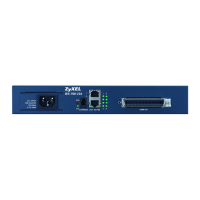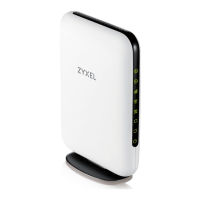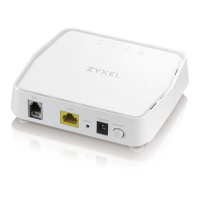Chapter 7 Interfaces
USG FLEX H Series User’s Guide
119
Role Select one of the following option depending on the type of network to which the Zyxel
Device is connected or if you want to additionally manually configure some related
settings.
Internal is for connecting to a local network. Other corresponding configuration options:
DHCP server and DHCP relay. The Zyxel Device automatically adds default SNAT settings for
traffic flowing from this interface to an external interface.
External is for connecting to an external network (like the Internet). The Zyxel Device
automatically adds this interface to the default WAN trunk.
Interface Type Select the type of interface you want to configure.
Name This field is read-only if you are editing an existing VLAN interface. Enter the number of the
VLAN interface. You can use a number from 0~4094. For example, use vlan0, vlan8, and so
on. The total number of VLANs you can configure on the Zyxel Device depends on the
model.
Zone Select the zone to which the VLAN interface belongs.
MAC Address This field is read-only. This is the MAC address that the VLAN interface uses.
Mode Select a Mode for this LAG interface. Choices are as follows:
• round-robin: Round-robin scheduling services queue on a rotating basis. A queue is
given an amount of bandwidth irrespective of the incoming traffic on that interface.
This queue then moves to the back of th list. The next queue is given an equal amount
of bandwidth, and then moves to the end of the list; and so on, depending on the
number of queues being used. This works in a looping fashion until a queue is empty.
• xor: Exclusively-OR (xor) balances the network traffic sent and received by the Zyxel
Device. Static Link Aggregation needs to be enabled on the device connected to the
Zyxel Device.
• active-backup: Active-backup is used when only one slave in the LAG interface is
active and another slave becomes active only if the active slave fails.
• LACP: Link Aggregation Control Protocol (LACP) negotiates automatic combining of
links and balances the traffic load across the LAG link by sending LACP packets to the
directly connected device that also implements LACP. The slaves must have the same
speed and duplex settings.
Miimom et the link check interval in milliseconds that the system polls the Media Independent
Interface (MII) to get status.
Link Interface This field displays Ethernet interfaces and VLAN interfaces that can become part of the LAG
interface.
Please see Section 7.3.3 on page 116 for criteria on available interfaces.
Select one, and click the > arrow to add it to the LAG interface.
Note: Up to 4 interfaces can be added to a LAG interface.
Description Enter a description of this interface. You can use up to 30 single-byte characters, including
0-9a-zA-Z’()+./:=?;!*#@$_%-”
Spaces are allowed, but the string can’t start with a space.
IP Address
Assignment
This option appears when Interface Type is external.
These IP address fields configure an IPv4 IP address on the interface itself. If you change this
IP address on the interface, you may also need to change a related address object for the
network connected to the interface. For example, if you use this screen to change the IP
address of your LAN interface, you should also change the corresponding LAN subnet
address object.
Get
Automatically
This option appears when Interface Type is external. Select this to make the interface a
DHCP client and automatically get the IP address, subnet mask, and gateway address from
a DHCP server.
Use Fixed IP
Address
This option appears when Interface Type is external. Select this if you want to specify the IP
address, subnet mask, and gateway manually.
Table 63 Network > Interface > Interface > Internal/External > Add (LAG)
LABEL DESCRIPTION

